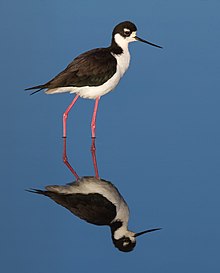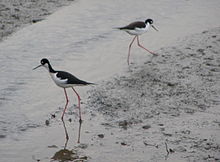Black-necked stilt
| Black-necked stilt | |
|---|---|

| |
| Adult near Corte Madera, California | |
| Scientific classification | |
| Domain: | Eukaryota |
| Kingdom: | Animalia |
| Phylum: | Chordata |
| Class: | Aves |
| Order: | Charadriiformes |
| Family: | Recurvirostridae |
| Genus: | Himantopus |
| Species: | H. mexicanus
|
| Binomial name | |
| Himantopus mexicanus | |

| |
| Range of black-necked stilt (including white-backed stilt of most of South America, see text) | |
| Synonyms | |
|
Himantopus himantopus mexicanus (Müller, 1776) | |
The black-necked stilt (Himantopus mexicanus) is a locally abundant
Taxonomy

It is often treated as a
Description

Measurements:[4]
- Length: 13.8–15.3 in (35–39 cm)
- Weight: 5.3–6.2 oz (150–180 g)
- Wingspan: 28.1–29.7 in (71–75 cm)
They have long pink legs and a long thin black bill. They are white below and have black wings and backs. The tail is white with some grey banding. A continuous area of black extends from the back along the hind neck to the head. There, it forms a cap covering the entire head from the top to just below eye-level, with the exception of the areas surrounding the bill and a small white spot above the eye. Males have a greenish gloss to the back and wings, particularly in the breeding season. This is less pronounced or absent in females, which have a brown tinge to these areas instead. Otherwise, the sexes look alike.[5]
Where their ranges meet in northern Brazil and central Peru, the black-necked and white-backed stilts intergrade. Such individuals often have some white or grey on top of the head and a white or grey collar separating the black of the hindneck from that of the upper back.
The black-necked stilt is distinguished from non-breeding vagrants of the black-winged stilt by the white spot above the eye. Vagrants of the northern American form in turn are hard to tell apart from the resident Hawaiian stilt, in which only the eye-spot is markedly smaller. But though many stilt populations are long-distance migrants and during their movements can be found hundreds of miles offshore,[6] actual trans-oceanic vagrants are nonetheless a rare occurrence.[5]
Distribution and habitat
The black-necked stilt is found in
This bird is locally abundant in the San Joaquin Valley, where it commonly winters.[8] It is common to locally abundant in appropriate habitat in southern California from April to September.[7]
It also breeds along lake shores in northeastern California and southeastern
For flocks that summer in the northern Central Valley of California, a migration occurs to the San Joaquin Valley to consolidate with flocks that were already summering there. In coastal areas flocks both summer and winter in these estuarine settings.
Fall migration of the northernly birds takes place from July to September, and they return to the breeding grounds between March and May. Usually, the entire population breeding at any one site arrives, mates, incubates eggs for about a month, and protects and broods the young until they are capable of sustained flight (at 27–31 days old) and leaves again migrating in flocks of about 15 individuals sometimes juveniles congregating in small groups and other times siblings with family groups.
The
-
Stilts exhibit a weak or sick behavior in order to distract predators from the location of their young.
-
Bolsa Chica Ecological Reserve
-
The Hawaiian stilt is usually considered a subspecies of the black-necked stilt.
Food and feeding

The black-necked stilt forages by probing and gleaning primarily in mudflats and lakeshores, but also in very shallow waters near shores; it seeks out a range of aquatic
Breeding

This stilt chooses mudflats, desiccated
The
Status
Particularly the North American populations of the black-necked stilt have somewhat declined in the 20th century, mainly due to conversion of habitat for human use and
Notes
- ^ Pierce (1996), Sibley (2003)
- ^ . Retrieved 9 December 2023.
- ^ E.g. Pierce (1996)
- ^ "Black-necked Stilt Identification, All About Birds, Cornell Lab of Ornithology". www.allaboutbirds.org. Retrieved 2020-09-30.
- ^ a b c d e f g h i Pierce (1996)
- ^ E.g. as a casual visitor on Clarión in the Revillagigedo Islands: Brattstrom & Howell (1953)
- ^ a b c Garrett & Dunn (1981)
- ^ McCaskie et al. (1979)
- ^ Corman & Wise-Gervais (2005)
- ^ Robinson, Julie A., J. Michael Reed, Joseph P. Skorupa and Lewis W. Oring. 1999. "Black-necked Stilt (Himantopus mexicanus)", The Birds of North America Online (A. Poole, Ed.). Ithaca: Cornell Lab of Ornithology; Retrieved from The Birds of North America Online: bna.birds.cornell.edu/bna/species/449
- ^ Sordahl, T. A. 1980. Antipredator behavior and parental care in the American Avocet and Black-necked Stilt (Aves: Recurvirostridae). Ph.D. thesis. Utah State Univ. Logan.
- ^ Dronen et al. (2006)
- ^ a b Himantopus mexicanus (Black-necked Stilt) The Online Guide to the Animals of Trinidad and Tobago. Retrieved 16 March 2023
- ^ Bent (1927)
- ^ Hamilton (1975)
- ^ Zeiner et al. (1988)
- ^ Rigney & Rigney (1981)
- ^ Harrison (1978)
- ^ Hays & Conant (2007)
References
- Bent, A.C. (1927). "Life Histories of North American Shorebirds: Order Limicolae (Part I)". Bulletin of the U.S. National Museum. 142: 1–420.
- BirdLife International (BLI) [2008]: Black-necked Stilt Species Factsheet. Retrieved 2008-SEP-24.
- Brattstrom, Bayard H. & Howell, Thomas R. (1956). "The Birds of the Revilla Gigedo Islands, Mexico" (PDF). JSTOR 1364977.
- Corman, T. & Wise-Gervais, C. (2005): Arizona Breeding Bird Atlas. University of New Mexico Press.
- Dronen, Norman O.; Gardner, Scott L. & Jiménez, F. Agustín (2006). "Selfcoelum limnodromi n. gen., n. sp. (Digenea: Cyclocoelidae: Cyclocoelinae) from the long-billed dowitcher, Limnodromus scolopaceus (Charadriiformes: Scolopacidae) from Oklahoma, U.S.A." (PDF). .
- Garrett, K. & Dunn, J. (1981): Birds of Southern California. Los Angeles Audubon Society.
- Hamilton, Robert Bruce (1975). "Comparative Behavior of the American Avocet and the Black-necked Stilt (Recurvirostridae)" (PDF). Ornithological Monographs. 17 (17): 1–98. JSTOR 40166701.
- Harrison, Colin (1978): A field guide to the nests, eggs and nestlings of North American birds. W. Collins and Company, Cleveland, Ohio.
- Hays, Warren S.T. & Conant, Sheila (2007). "Biology and Impacts of Pacific Island Invasive Species. 1. A Worldwide Review of Effects of the Small Indian Mongoose, Herpestes javanicus (Carnivora: Herpestidae)". S2CID 86338152.
- McCaskie, G.; DeBenedictus, D.; Erickson, R. & Morlan, J. (1979): Birds of Northern California, an annotated field list (2nd ed.). Golden Gate Audubon Society, Berkeley, California.
- Pierce, Ray J. (1996): 1. Black-winged Stilt. In: del Hoyo, Josep; Elliott, Andrew & Sargatal, Jordi (eds.): ISBN 84-87334-20-2
- Ransom, Kay et al. (1984): Environmental Impact Report for the Corinthian Villas Project on Richardson Bay. Report prepared for the city of Mill Valley by Earth Metrics Inc.
- Rigney, M. & Rigney, T. (1981): A breeding bird survey of the south San Francisco Bay salt pond levee system. U.S. Department of the Interior, San Francisco Bay National Wildlife Refugespecial report
- Robinson, Julie A., J. Michael Reed, Joseph P. Skorupa and Lewis W. Oring. (1999). Black-necked Stilt (Himantopus mexicanus), The Birds of North America Online (A. Poole, Ed.). Ithaca: Cornell Lab of Ornithology. Birds of North America.
- ISBN 067945120X.
- Sordahl, T. A. 1980. Antipredator behavior and parental care in the American Avocet and Black-necked Stilt (Aves: Recurvirostridae). Phd Thesis. Utah State Univ. Logan.
- Zeiner, David C.; Laudenslayer, William F. & Meyer, Kenneth E. (eds.) (1988): California Wildlife (Vol. 2 Birds). California Department of Fish and Game.
Further reading
- Hayman, Peter; Marchant, John & Prater, Tony (1986): Shorebirds: an identification guide to the waders of the world. Houghton Mifflin, Boston. ISBN 0-395-60237-8
- Stiles, F. Gary & Skutch, Alexander Frank (1989): A guide to the birds of Costa Rica. Comistock, Ithaca. ISBN 0-8014-9600-4
External links
- Black-necked Stilt Himantopus mexicanus—USGS Patuxent Bird Identification InfoCenter
- Black-necked Stilt Species Account—Cornell Lab of Ornithology
- Black-necked Stilt photo gallery at VIREO (Drexel University)
- Interactive range map of Himantopus mexicanus at IUCN Red List maps




